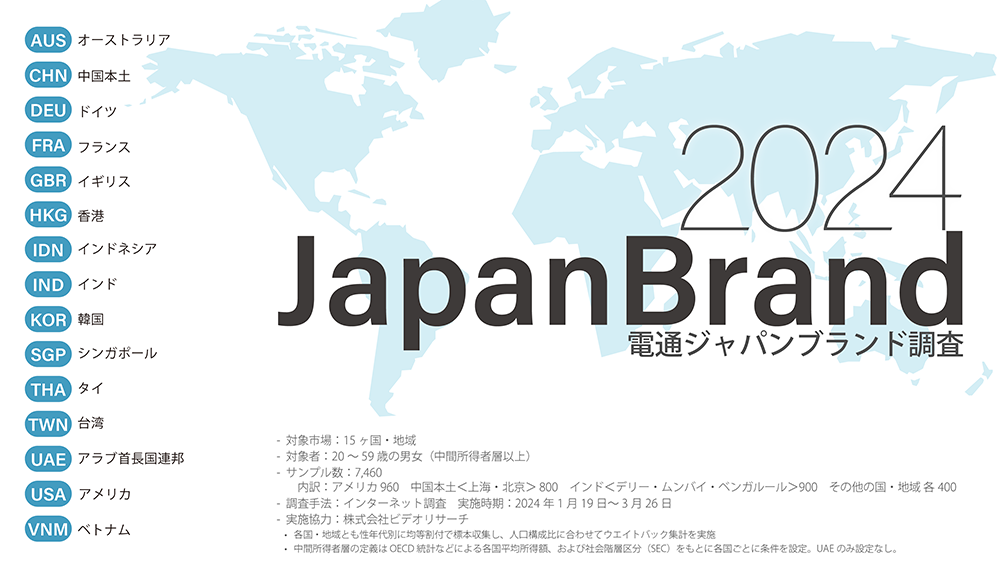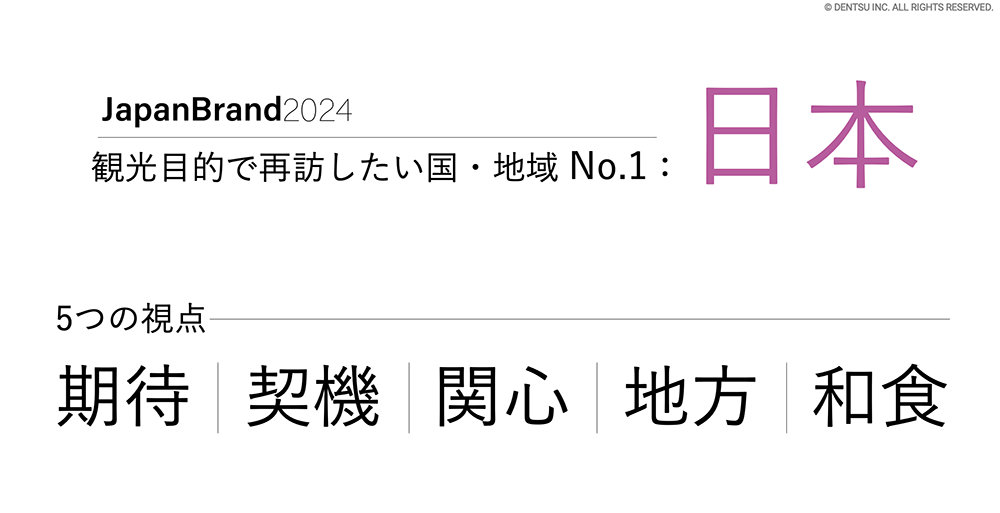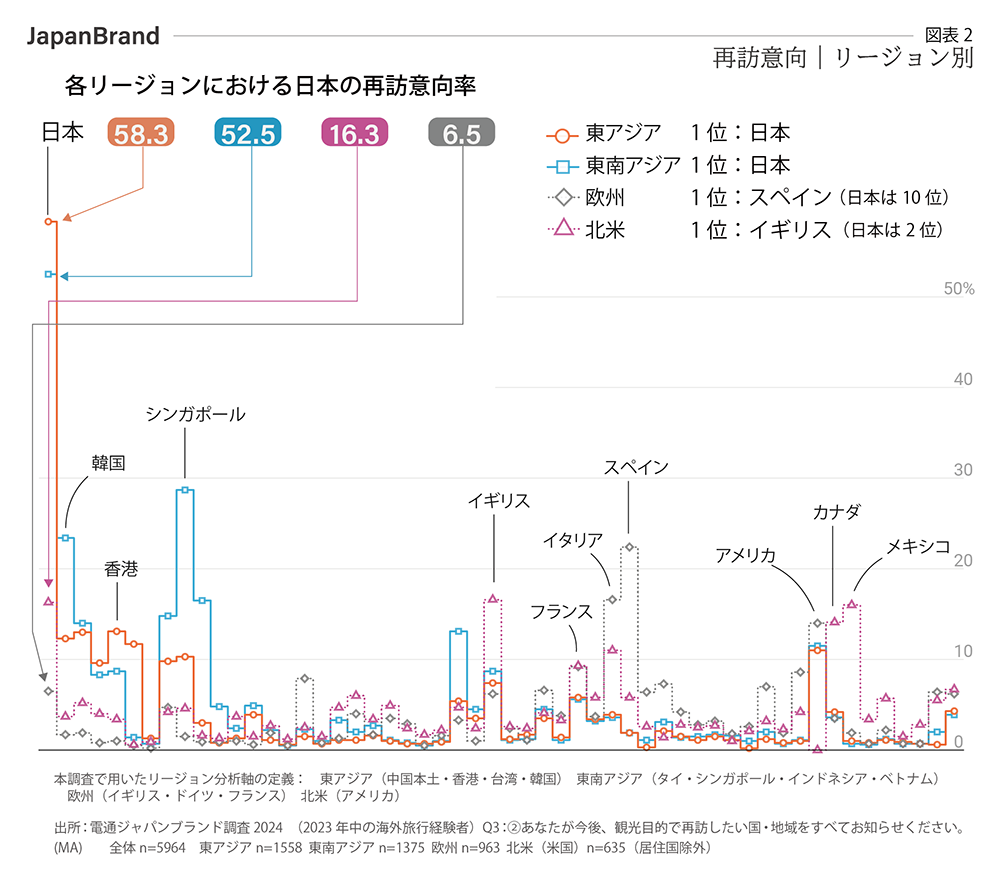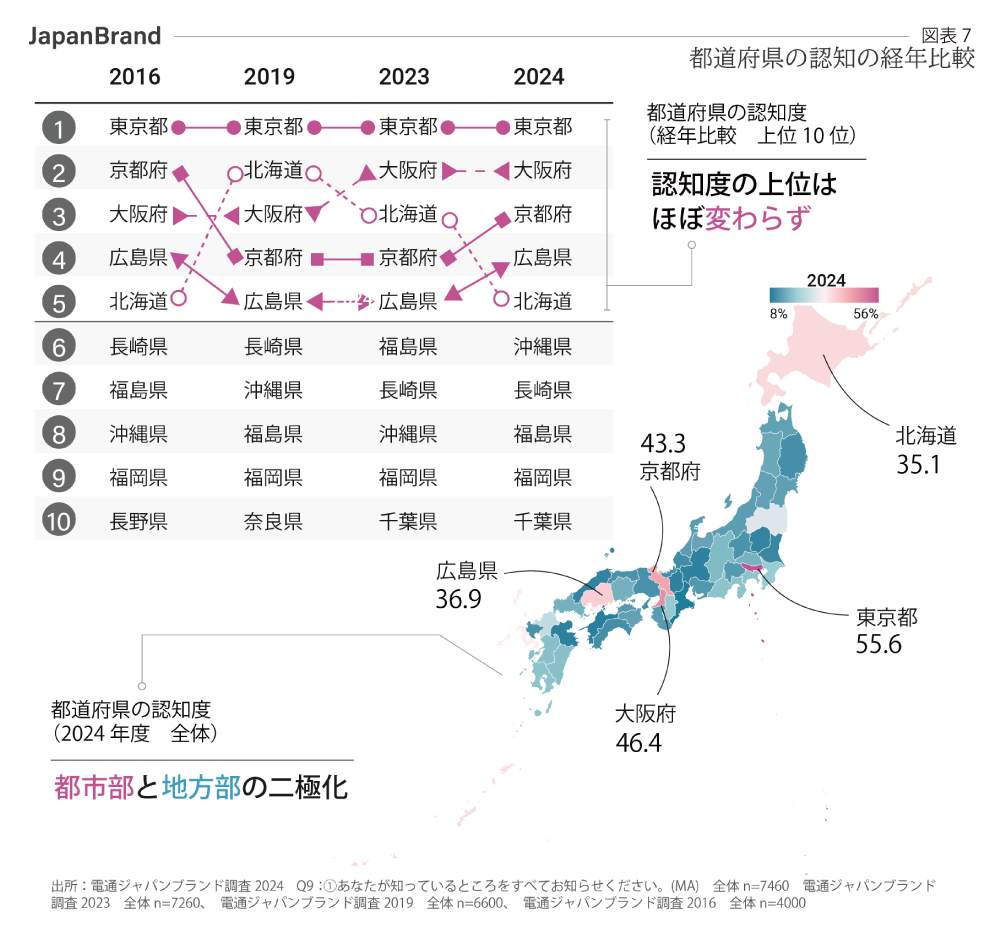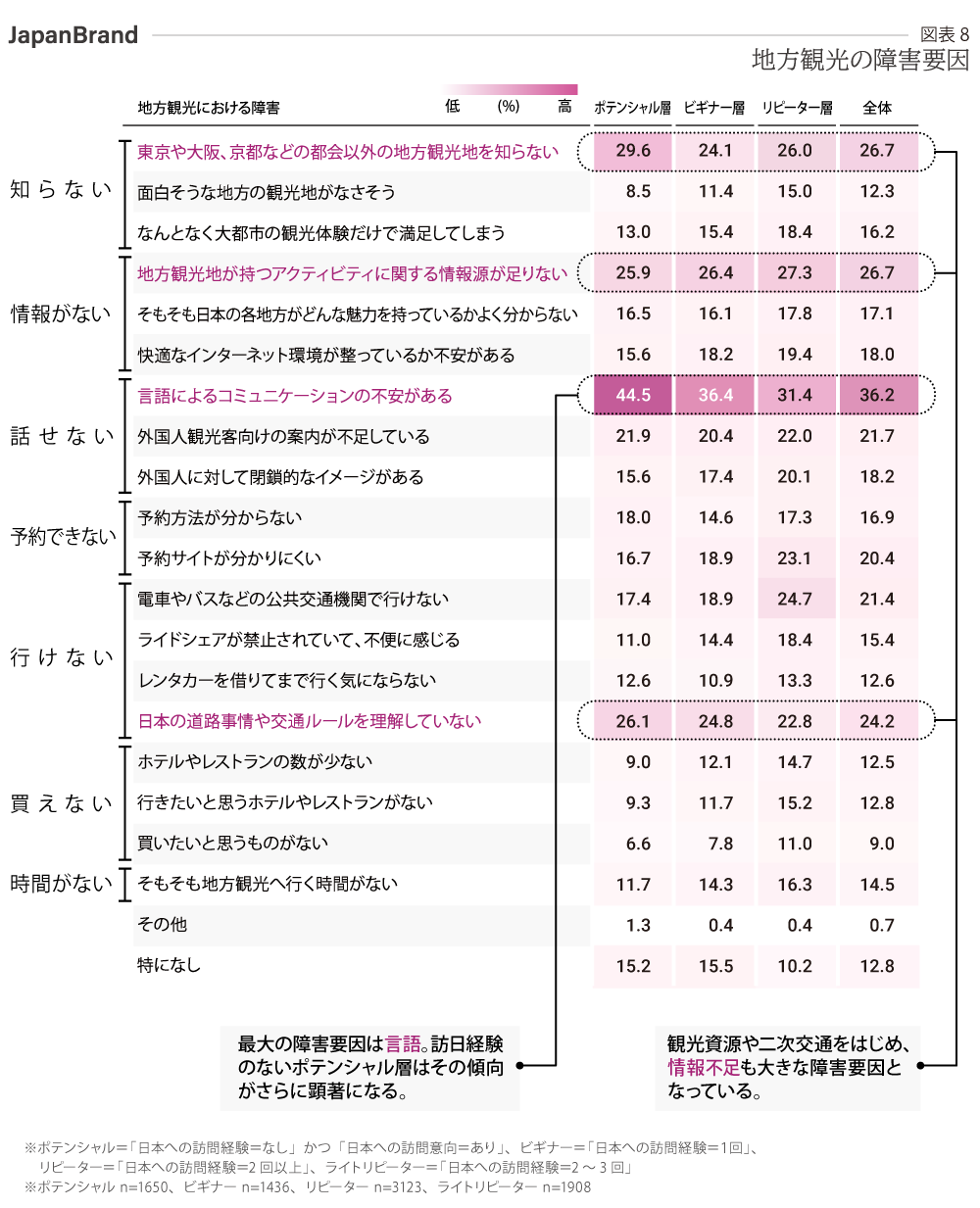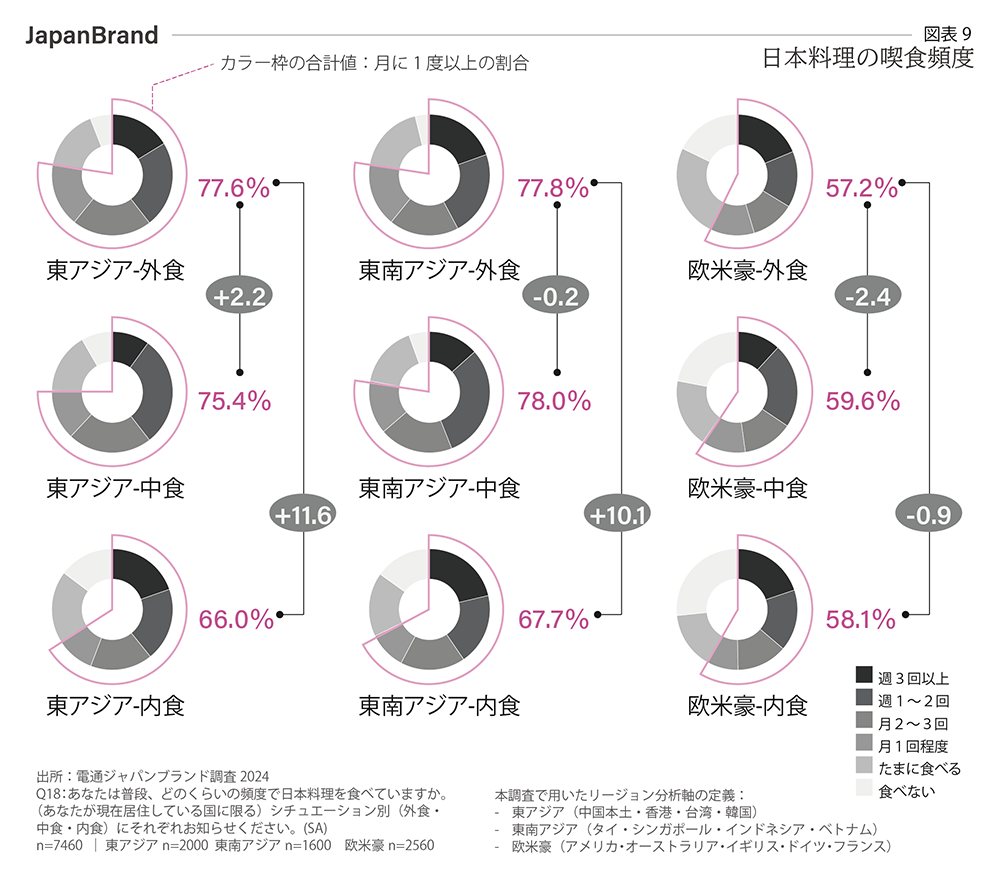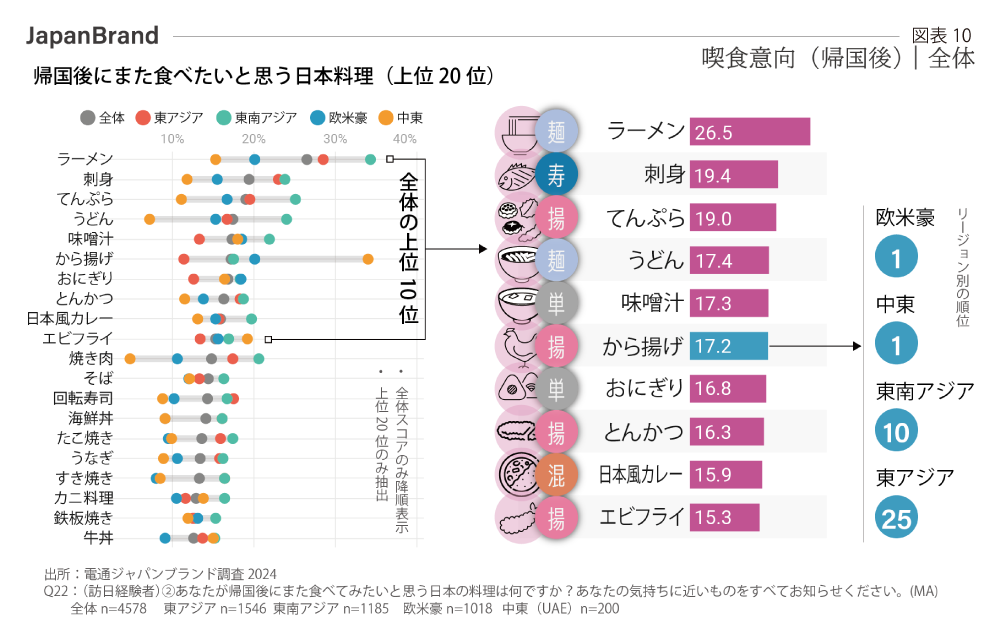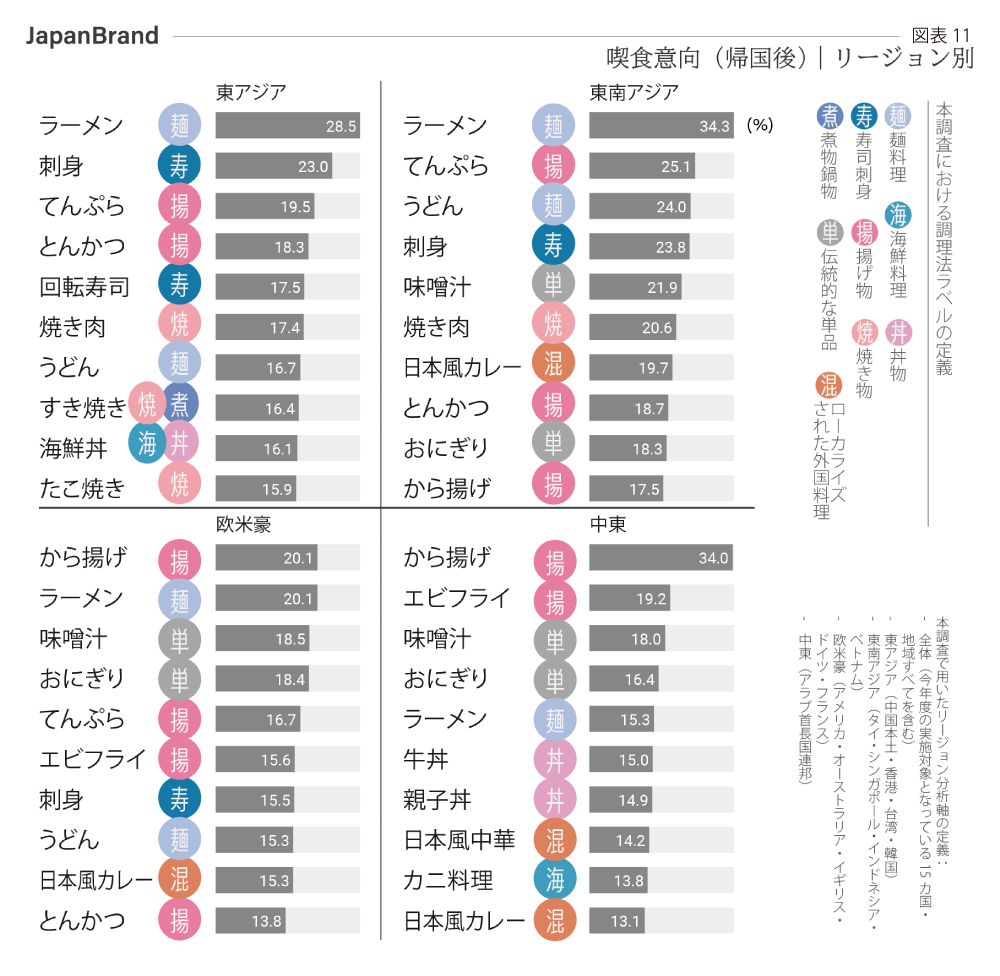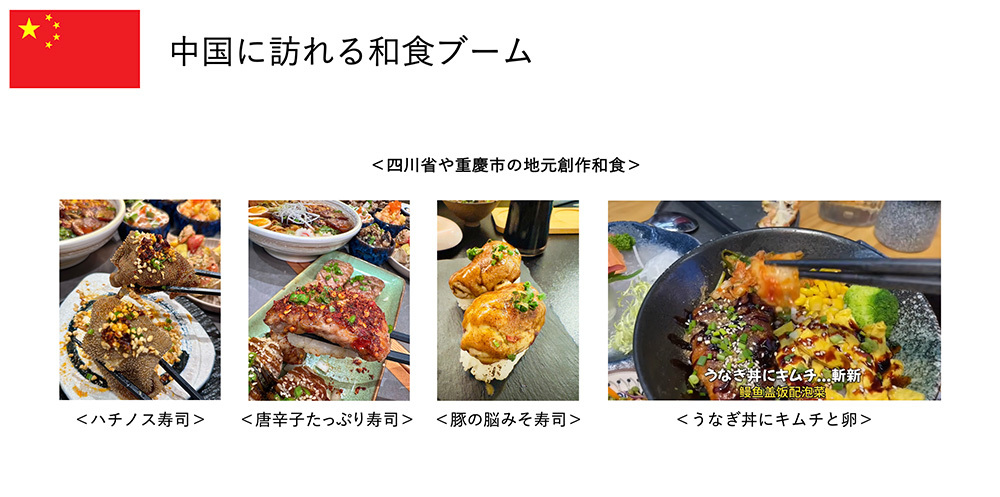Japanese brands have already spread worldwide. Among them, Japanese cuisine is now loved globally not as an "interesting foreign culture," but as "WASHOKU—a familiar taste." This time, from the sessions at "Advertising Week Asia 2024" held in September, Part 1 presents a summary of the Japan Brand Survey results, while Part 2 offers insights into "Japanese food" beloved overseas and its future. We share part of the discussion between renowned PR strategist Tetsuya Honda and Dentsu Inc. Japan Brand Survey Team members Hitomi Komatsu and Ming Xie.
Japan is the No. 1 country people want to revisit for tourism
Komatsu: Today, I'd like to share findings from Dentsu Inc. conducted 'Japan Brand Survey 2024' and discuss related anecdotes. First, a brief introduction.

Honda: I usually work in PR, but today I'm not here to talk about PR. Since I actually moved to Singapore last year and now live between two bases, I hope to share perspectives on Japan from an overseas viewpoint.
Komatsu: I work as a Strategic Planner at Dentsu Inc. I started as a researcher at an IT systems company, then joined Dentsu Inc. where I handled communication strategies for consumer goods companies. After assignments at a foreign agency and Dentsu Digital Inc. outpost, I was stationed in Thailand for four years starting in 2019. I returned to Japan this January and now work at Dentsu Inc.'s headquarters.
Kai: I work as a Strategic Planner at Dentsu Inc. I grew up in China until age 20 and spent my university years in Japan. Since joining Dentsu Inc., I've focused on branding and marketing work for clients primarily in Japan and Greater China. As part of Dentsu Inc. Japan's Brand Research Team, I'd like to share our latest findings and discuss inbound trends specifically around Greater China.
Komatsu: The three of us have lived in Thailand, Singapore, and China respectively. In Part 1, we'll present the survey results, focusing on the top-line findings. In Part 2, we'll incorporate our personal experiences to provide a more tangible perspective on the survey results.
Dentsu Inc.'s Japan Brand Survey was conducted this year across 15 countries and regions.
To summarize the results briefly: among the 15 target markets, Japan ranked number one as the country or region that tourists who visited once most want to revisit. We've summarized this under five key perspectives.
The first perspective is [Expectations]. Japan ranked first in revisit intent at 34.6%. It holds a significant lead, with a gap of about 20 points over second-place Singapore and third-place America.
Looking at respondents by region, Japan ranked first in East Asia and Southeast Asia. While the UK and Spain were the top choices in North America and Europe respectively, Japan still ranked 10th in Europe and 2nd in North America, clearly demonstrating its high appeal for repeat visits.
What makes people want to revisit Japan?
Komatsu: When we asked those with a desire to revisit what they expect from Japan, "Food" ranked first. "Unique culture" followed closely in second place. Next came "Natural landscapes not found elsewhere." "Coexistence of modernity and tradition" and "Cleanliness unmatched by other countries" also ranked highly. This clearly shows that people come to Japan to experience its uniqueness in food and culture.
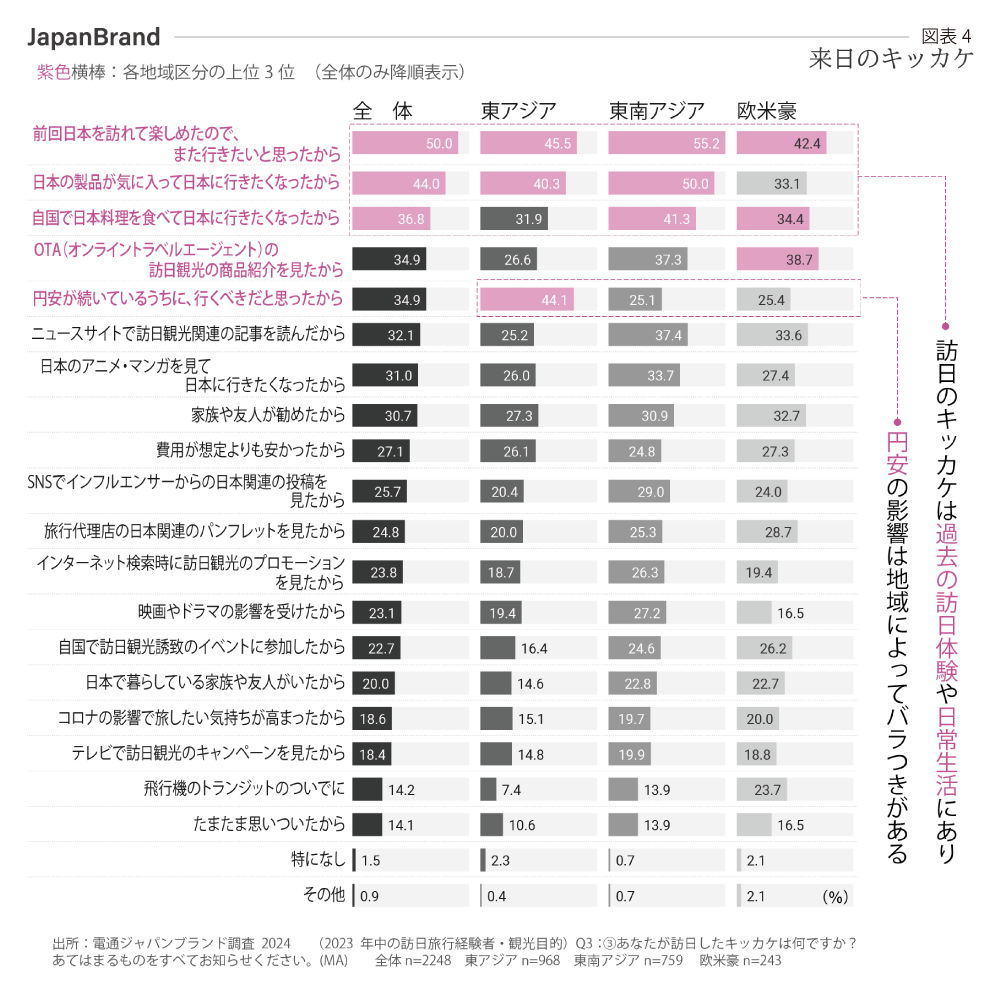
Now, regarding the 【Trigger】—what prompted their visit to Japan? As commonly noted in media, the impact of the weak yen is evident. However, even more strongly, "Having visited Japan before and wanting to go again" stands out. The desire to return due to a positive experience is high across all regions. Furthermore, triggers like "Liking Japanese products" and " " or "Wanting to eat Japanese cuisine back home" also show high numerical values.
What do you want to do in Japan?
Komatsu: Regarding the third perspective, [Interest]. Here are the responses to the question, "What would you pay to experience when visiting Japan?" Overall, "down-to-earth Japanese restaurants" and "farm stays" rank high. There's also interest in riding the "Shinkansen" and visiting "high-end Japanese restaurants," showing a mix of both accessible and upscale experiences. "Purchasing traditional crafts" is also included.
Looking deeper, we see that alongside "down-to-earth Japanese restaurants," "izakaya" (Japanese pubs) were also chosen, and alongside "Shinkansen," "taxi" was selected. This shows that dining and transportation are sought across several layers.
When broken down by country/region, the rankings actually differ significantly, clearly showing country-specific variations. This reveals country/region-specific characteristics not apparent from the overall score.
Barriers to Visiting Regional Areas
Komatsu: The fourth factor is [Regional Areas]. When examining prefectural recognition over time, the top five rankings actually shift, but the prefectures themselves remain consistently the same. The same prefectures fluctuate in rank but remain established. Positions 6 to 10 also show little change, indicating that regional options still lack significant breadth.
Analyzing barriers to regional tourism, the clear conclusion is "lack of awareness." Some people simply don't know what kind of tourist destinations exist there. Others lack information on what activities are available in that region or don't understand how to get there or the transportation networks.
However, the highest-ranked concern by category is "anxiety about language barriers in communication." Language concerns can be seen as one barrier to regional tourism.
Popular Japanese cuisine varies by region
Komatsu: Finally, we have [Japanese Cuisine]. There were regional differences in the frequency of eating Japanese food. In East Asia and Southeast Asia, eating out and takeout/delivery were common, while home cooking was less frequent compared to those. For Europe, America, and Australia, the overall frequency was lower than those two regions, and there wasn't much difference between eating out, takeout/delivery, and home cooking.
*Regarding the definition of consumption situations
・Prepared meals (purchasing pre-cooked foods, takeout like bento boxes or side dishes, delivery, etc. – consuming food prepared outside the home at home or work)
・Home-cooked meals (meals prepared at home)
When asked which Japanese food they wanted to try in their home country after returning from Japan, ramen was the overwhelming top choice. Regionally, Southeast Asia led the scores, followed by East Asia. The Middle East, however, scored lower. Again, rather than focusing on overall scores, it's important to see what specific foods people from each region want to eat.
Looking at the top rankings by region in this table, the order is clearly different at a glance.
The most popular Japanese food in China is "sushi."
Komatsu: Now, I'd like to hear your opinions. We'll discuss the five perspectives—Expectations, Opportunities, Interests, Regions, and Japanese Cuisine—in reverse order from earlier, starting with Japanese Cuisine.
The results showed ramen is extremely strong. Based on my experience in Thailand, ramen is indeed very popular there, and I feel a "Japanese-style ramen culture in Thailand" is developing. How about in China?
Kai: What we're focusing on is "sashimi and conveyor-belt sushi." This is because, while ramen ranked first overall in the survey at 26.1%, when focusing solely on China, the top spot wasn't "ramen" (18%) but "sashimi" (20.1%). Looking at gender × generation, the consumption intent for "sashimi and conveyor-belt sushi" is high among young people in their 20s, surpassing ramen for both. Specifically, the desire to eat "conveyor belt sushi" among women in their 20s and the desire to eat "sashimi" among men in their 20s were both about 8% higher than for ramen. While one might naturally assume ramen would be popular among men in their 20s, surprisingly, in China, it's sashimi and conveyor belt sushi. This shows the popularity of sushi, so I'd like to expand a bit on sushi in China.
During a recent business trip to Beijing, a hot topic locally was Sushiro opening its first store in the city. Seeing the news coverage of its bustling crowds really drove home just how popular "sushi" has become in China. Sushiro first entered mainland China in 2021, starting its expansion in southern Guangdong Province before moving inland to cities like Chengdu and Wuhan. This time, it expanded northward, opening its first store in the capital, Beijing.
The story of how sushi gained popularity in China is fascinating, so let me share it. China traditionally had no culture of eating raw foods. Initially, sushi began to gain traction in high-end Japanese restaurants frequented by Japanese expatriates. Back then, sushi establishments seemed quite polarized. While some offered ultra-luxurious, ultra-fresh sushi, others served what was technically sushi but, frankly, wasn't very tasty (laughs) – the cheap kind.
Later, as the middle class grew wealthier with the times, their purchasing power and awareness of food quality increased. I believe this was influenced by experiences like discovering the deliciousness of Japanese cuisine during trips to Japan around 2014-15, as well as the popularity of Japan-themed content focused on Japanese food, such as "Midnight Diner." According to surveys by JETRO (Japan External Trade Organization) and the Ministry of Agriculture, Forestry and Fisheries, the number of Japanese restaurants in China surged over fivefold in a decade, from about 15,000 nationwide in 2013 to approximately 79,000 by 2023. The Japanese food boom in China is remarkably visible. Riding this wave, so-called Japanese itamae sushi became popular in China's coastal cities. It became possible to enjoy sushi prepared by a skilled chef at an affordable price of around ¥20,000 to ¥30,000.
Then, around 2020 when travel to Japan became impossible due to the pandemic, conveyor-belt sushi brands accelerated their expansion pace in China. Hamazushi opened its first Shanghai location in 2014 and expanded from 12 stores at the end of 2020 to 60 stores. Behind this growth is the "smartification of sushi." In other words, a business model has emerged that can provide affordable sushi while ensuring quality, covering areas like ingredient procurement, quality control, and service delivery.
Honda: That's interesting. This slide from China is also about sushi, right?
Kai: Yes, this is local sushi from Sichuan Province and Chongqing City. It features abundant local creativity, like generous amounts of chili peppers on the toppings, sushi made with pig's stomach or pig's brain, and eel rice bowls topped with kimchi. While sushi is commonly associated with major cities along the southeast coast like Shanghai and Guangzhou, it has also penetrated inland hubs such as Chengdu and Wuhan. However, due to regional distinctiveness, it's notably localized significantly from store to store.
Honda: It's quite different from what's eaten in Japan.
Komatsu: How about Singapore?
Honda: Well, Singapore truly gathers cuisine from all over—Asia, Europe, America, India—and the level is exceptionally high. Amongst it all, Japanese food remains very popular. Sushiro has quite a few locations in Singapore now; you practically need a reservation to get in.
Komatsu: Thailand is similar.
Kai: Japanese cuisine has now established a global brand image as "delicious, healthy, visually appealing, and trustworthy." In China, a local brand achieved success by building a comprehensive marketing strategy—from product development and packaging design to distribution channels and communication—inspired by this image of Japanese food and beverages. While there are several success stories, the most typical example is a certain beverage brand.
It's a truly fascinating success story, but explaining the background of its product development would take too long. Simply put, both at the branding layer and the marketing layer, they cultivated an image evoking Japanese beverages: "healthy, stylish, delicious, and youthful."
In the Marcom (Marketing Communications) domain, they implemented a thorough communication strategy targeting young people. At the top of the funnel, they maximized the use of social media to expand awareness among young people and foster brand image. Simultaneously, we avoided supermarkets—where major existing manufacturers held strong positions—and focused capital investment on convenience stores and e-commerce. This "vertical" marketing approach—combining full SNS utilization for brand image building with partnerships in target youth-frequented channels like convenience stores and e-commerce—achieved rapid success. It garnered significant attention as a growth star in its category.
Japanese Food Trends in Thailand and Singapore
Komatsu: I'd also like to touch on Thailand. Among Japanese restaurants in Thailand, I get the impression yakiniku (grilled meat) restaurants are proliferating rapidly. In rural areas of northeastern Thailand, people sometimes eat beef raw, but outside that region, Thais didn't consume much beef. When I asked Thai acquaintances, they explained that people come to Japan, discover delicious beef, and then return to Thailand. As more people became familiar with that high-quality meat flavor, yakiniku restaurants began increasing within Thailand itself.
Honda: Are these yakiniku restaurants primarily run by Thai capital? Or is it Japanese capital?
Komatsu: I think most are Thai-owned. While some cater to Japanese customers, the ones Thais really frequent tend to be Thai-owned. I'm impressed by how well-researched they are.
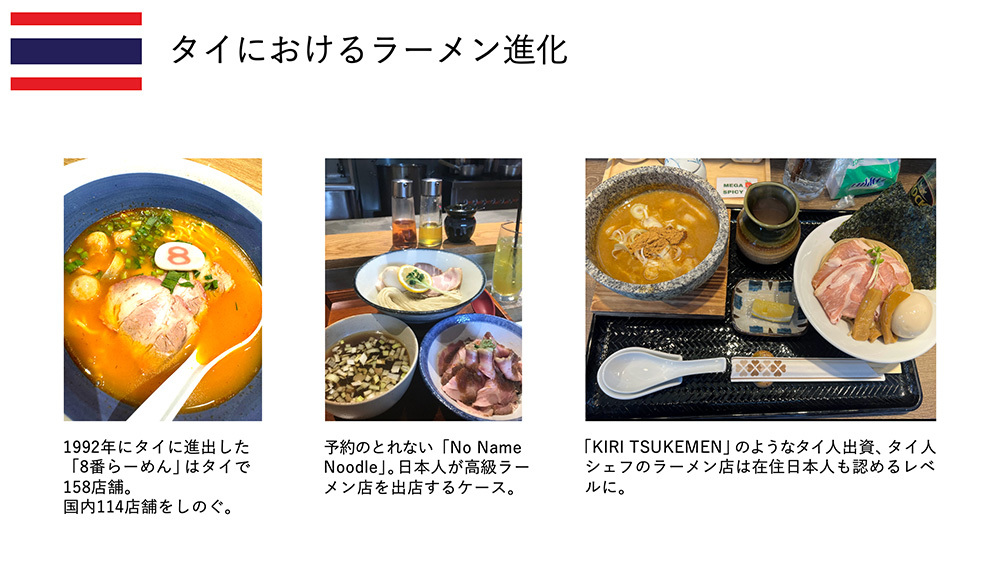
As for Thai ramen, I'm originally from Kanazawa City. For people from Ishikawa Prefecture, "8-ban Ramen" is soul food; I've been eating it since I was a kid. A Thai businessman came to Ishikawa Prefecture, tried this ramen, and thought, "I want to do this in my country too." He started expanding it in Thailand in 1992.
Honda: There are a huge number of stores in Thailand!
Komatsu: Exactly. More than in Japan. So when I went to Thailand, I was thrilled to share soul food with the Thai people. As you see in the center photo, Japanese people have opened high-end ramen shops, but they're packed with Thai reservations. The right photo shows a shop owned by a Thai person. They've researched it thoroughly and made it to a level where even Japanese people find it truly delicious. It's evolved tremendously. What about Singapore?
Honda: I was genuinely surprised when I went to Singapore and saw how far it had come. When talking about the relationship between Singapore and Japanese brands, "Don Quijote" is indispensable. It's completely different from the perception Japanese people have of Donki; it's a supermarket specializing in fresh produce. Under the brand "DON DON DONKI," they operate 16 stores.
No matter which shopping mall you go to, Donki is there, just like Uniqlo. As a Japanese person, it's something to be proud of, but it operates in a completely different way than in Japan. Honestly, I never imagined going to Donki to buy ingredients for dinner. When points of contact with Japan become this accessible locally, it sparks interest in Japan among locals too. They might think, "I'll try eating the things I bought at Donki when I go to Japan." I believe this kind of opportunity exists.
That concludes the AWA session introduction by members with experience living in Asia. Finally, Ryunosuke Tsuzuki, also a member of the Dentsu Inc. Japan Brand Research Team, will share insights on Japanese food trends in the U.S., where he has lived.
Even on the West Coast of the U.S., where I spent my student years, Japanese food was extremely popular and developed its own unique food culture adapted to the needs of the times.
When I first arrived in the U.S. in 2001, Japanese food options were limited. Even ramen, now hugely popular, was mostly found in small shops frequented by local Japanese residents and their neighbors.
Eventually, growing interest in Japanese culture driven by soft power via the internet led to Japanese brands landing one after another, primarily in shopping centers. Although the prices were three to four times higher than in Japan, it was not uncommon to see long lines.
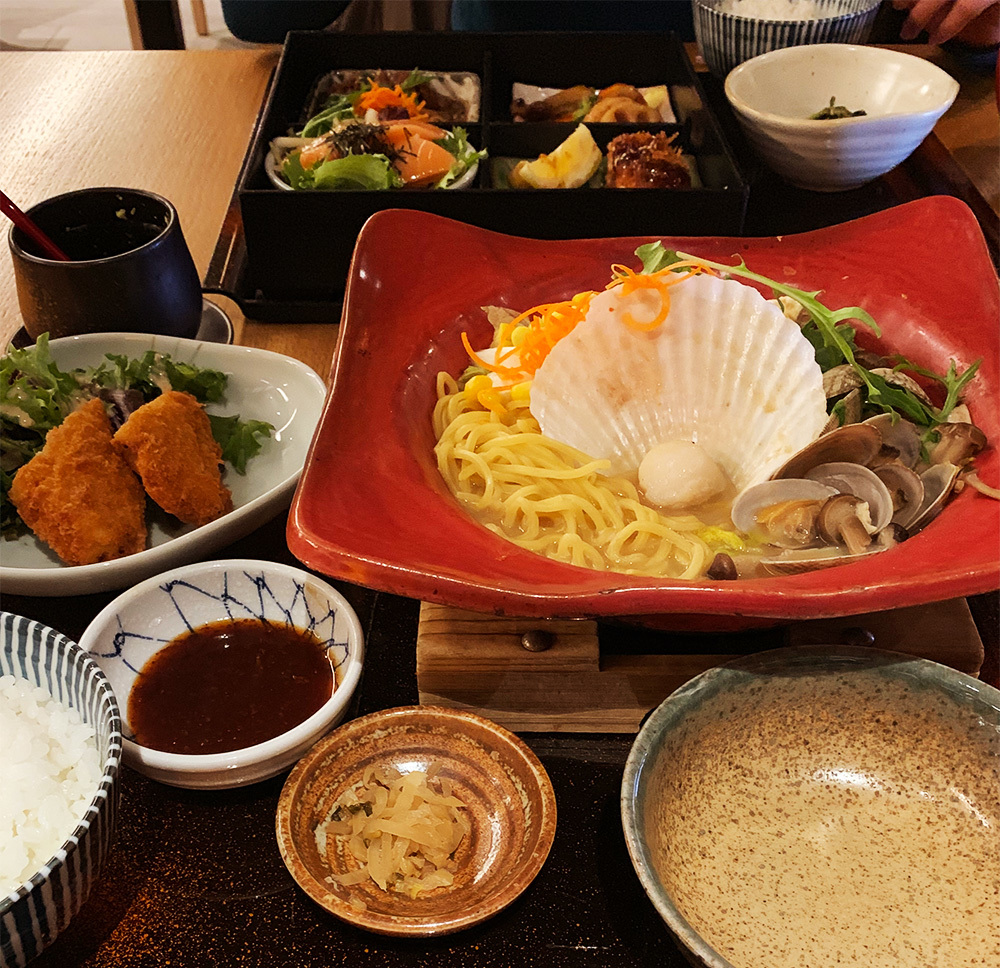
Photo shows examples from a local "Yayoi-ken" menu. Front: Seafood Noodle Set Meal. Back: Yayoi Special Meal
After that, the shift in awareness towards healthier eating habits post-COVID led to a greater emphasis on the "freshness" of food, which I feel has strengthened the association between Japanese cuisine and health.
Particularly, raw dishes like sushi and sashimi, being readily accessible, are gaining acceptance among a broader demographic. Japanese cuisine, once considered a niche "ethnic food," now enjoys enduring popularity as a prime example of healthy dining.
※1: Country and region names in this article are written according to Japanese social norms and business practices, assuming a Japanese domestic readership.
※2: The percentages in this survey are rounded to the second decimal place (or first decimal place for some whole numbers), so the total may not add up to 100%.
※3: The maps used in this survey (world map and Japan map) have been partially modified, processed, or cropped to suit the analysis content and page layout. They do not necessarily accurately reflect national borders or territorial boundaries.
※4: When creating figures and tables, country/region names use ISO 3166-1 alpha-3 codes due to space or layout constraints.
【Contact for Inquiries Regarding This Matter】
Dentsu Inc. Japan Brand Survey Project Team
japanbrand@dentsu.co.jp
【About the Dentsu Inc. Japan Brand Survey】
Dentsu Inc.'s proprietary survey launched in 2011 to understand how the Japan brand was perceived globally when reputational damage affected Japanese agricultural and marine products and inbound travel following the Great East Japan Earthquake. In 2022, the survey underwent a major redesign of its methodology and outputs, evolving into a company-wide cross-functional project.
It regularly gauges the awareness and actual attitudes of overseas residents regarding the Japan Brand as a whole, covering areas such as inbound tourism, food, Japanese products, content, and values. By visualizing the changing sentiments of consumers and the challenges facing the Japan Brand, it contributes to increasingly complex corporate activities and promotes cross-cultural understanding within Japanese society.
【Dentsu Inc. Japan Brand Survey 2024 Overview】
・Target Areas: 15 countries/regions (United States, Australia, United Kingdom, Germany, France, India, United Arab Emirates, Indonesia, Singapore, Thailand, Vietnam, Mainland China, Hong Kong, Taiwan, South Korea)
・Respondent Criteria: Men and women aged 20-59 (middle-income and above)
・Sample Size: 7,460 (Breakdown: USA 960, India 900, Mainland China 800, Other countries/regions 400 each)
・Survey Method: Online survey
・Survey period: January 19 to March 26, 2024
・Research Agency: Video Research Ltd.
※5: Mainland China survey areas limited to Shanghai and Beijing; India survey areas limited to Delhi, Mumbai, and Bengaluru.
※6: Definition of middle-income earners: Conditions set per country based on national average income (using OECD statistics, etc.) and the Socio-Economic Classification (SEC).
※7: For all countries/regions, samples were collected with equal allocation by gender and age group, then weighted to match the population composition.










